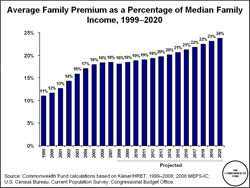As health reform advanced through congressional committees this summer, much attention was given to trimming the federal budget cost and slowing the growth in Medicare outlays. But equal attention needs to be focused on provisions to address the rising costs of health insurance premiums for employers and families. Health system reform will be effective only if the legislation considers the financial well-being of all participants, not just that of the federal government. It is time to ask what effect health reform will have on the cost of insurance for businesses and families—and to remember what will happen if we do nothing. Without reform, projected premium increases will put the country at high risk for having health insurance costs absorb all of the average family's future wage increases, eventually pricing middle-income families out of insurance altogether.
Health insurance is already becoming unaffordable for families and businesses, with premium inflation outpacing wage increases. Between 1999 and 2008, employer family health insurance premiums rose by 119 percent, while the median family income rose by less than 30 percent. As a result, average family premiums for group policies have risen from 11 percent to 18 percent of median family income. And if Congress fails to pass health reforms that control health care costs, premiums are projected to rise to 24 percent of a family's income by 2020. (Click on image at right to open chart.) In any economic climate, but especially in today’s recession,  most families cannot afford to devote a fourth of their income to insurance coverage, nor can businesses afford their share of insurance premiums in addition to raises for employees.
most families cannot afford to devote a fourth of their income to insurance coverage, nor can businesses afford their share of insurance premiums in addition to raises for employees.
In light of this reality, it is important to remember the principal goals of comprehensive health reform: 1) to cover the uninsured, 2) to enhance the affordability of insurance coverage for everyone, and 3) to slow the rise in health care costs. Achieving the first goal without the second and third is a recipe for long-term failure.
The Public Plan: The Leverage to Set Rates
Although the Obama Administration may be scaling back its support for a public plan, Commonwealth Fund and Congressional Budget Office (CBO) analyses show that offering a strong public health insurance choice as well as private plans through a health insurance exchange will help all Americans, not just the uninsured, by slowing the growth in premiums. A recent Fund analysis found that offering a public plan alongside private plans to all individuals and employers is our most effective weapon in combating health care costs. The study found that cumulative health system savings between 2010 and 2020—compared with projected trends for that period—could be as high as $3 trillion if reform includes a public plan that adopts innovative payment methods that reward value and uses its purchasing leverage, along with a reformed Medicare program, to control costs. The annual growth rate in health system spending would fall from 6.5 percent to 5.2 percent—consistent with an industry coalition pledge to slow spending by 1.5 percentage points annually over the next decade.
The CBO estimates that a public plan premium would be 10 percent lower than that of typical private plans offered in an insurance exchange—a cost break that would provide much-needed relief to families and businesses in every state in the country. The average family would save $2,200 per year by 2020 with reforms that include a public plan. President Obama pledged during the presidential campaign to save American families $2,500 a year through health reform. This goal needs to be on par with a deficit-neutral health reform plan.
The public plan would achieve these savings because it would use the federal government’s power to set prices for health care providers and control the rate of increase in these prices over time. It would be most effective if it were linked to Medicare, either paying at or somewhat above Medicare rates. Today, nearly all hospitals and physicians choose to participate in Medicare, rather than lose the 20 percent to 30 percent of revenues or more they derive from such participation. This leverage prevents providers from obtaining prices far in excess of their costs—as they often do under private insurance “negotiations” based on their dominant market position. Prices can be many times the Medicare rate when providers refuse to participate in private insurance networks and simply charge patients whatever they choose, patients are left uninformed and unprotected from the financial consequences.
By using its substantial purchasing power, a public plan that links payment and participation to Medicare could provide relief to employers and households by offering a lower premium. Such a premium would challenge private insurers to bring more value to the insurance market by using tools such as utilization management; creating networks of providers that offer real value for the care they provide; and rewarding accountable care organizations and integrated delivery systems for preventing and controlling chronic conditions.
Private insurers have opposed the creation of a public plan, arguing that Medicare payment rates under a public plan would lead to a “cost-shift” of higher prices to private payers. Instead of proposing an alternative solution that would work to control costs, insurers have simply insisted that there be no public plan option.
It is certainly reasonable to demand that a public plan meet the same market conditions as private plans, for example by requiring it to be self-sustaining, with premiums sufficient to cover projected medical outlays and administrative overhead, and ensuring that public and private plans are held to the same standards for adequate financial protection and access for enrollees. But abandoning a public plan without proposing an alternative that would achieve real value and slow the growth in health spending undermines the long-term success of health reform and puts our economy at risk.
Unfortunately, as legislation has worked its way through congressional committees, the potential power of a public plan has been substantially eroded in three ways: by dropping the requirement that providers that receive Medicare payment also participate in the public plan; by requiring the U.S. Health and Human Services Secretary to negotiate provider payments rather than base prices on Medicare rates; and by restricting access to a public plan option to individuals and small firms. As a result, a strong public option is no longer a component of several bills now being debated in Congress.
The Senate Finance Committee is considering nonprofit health care cooperative plans as an alternative to a public plan. While the details of this proposal are unclear, it is unlikely that such organizations would have sufficient purchasing power to control costs over time and would take years to evolve. Whether we are considering a public health insurance plan or nonprofit cooperative plan, if the plan does not link payment to Medicare rates, it loses the advantage of representing the share of enrollees, and therefore provider revenues, needed to obtain lower prices. The Congressional Budget Office estimates that only 9 million to 12 million people would be enrolled in these plans as currently designed. Negotiating provider payments for the 10 million or so people estimated to enroll in a public plan or private co-op plan is unlikely to yield significant savings.
In response to the increasing concentration of the insurance industry, the health care provider industry has formed its own large organizations that can command high payment rates. In many markets, one to four large hospital systems dominate. Such systems can easily decline to participate with a weakened public plan or private co-ops, knowing it will not affect a substantial share of their revenues. With only a limited number of individuals covered and restrictions on the ability to set payment rates, a public or nonprofit cooperative plan will be unable to counter the concentrated market powers of providers in a given geographic area. As a result, we are likely to continue on the current course, with employers and families seeing premiums continue to rise far faster than incomes.
Other Options for Cost Containment
To truly contain costs, health reform needs to include some mechanism for controlling both medical outlays and insurance administrative overhead. A strong public plan is one effective option; there are certainly others. For example, one approach would be to negotiate provider payments under all plans—public or private. This is the model followed by most industrialized countries that leverage purchasing power by having a single entity—either a government agency or a non-profit entity acting in the public interest—negotiate provider payment rates and methods on behalf of the entire population.
Another option would be to charge states with designing and implementing all-payer methods of provider payment. States with a plan that ensures fair and reasonable payment rates and methods that reflect value, harmonizes payment under public programs and private insurance, and effectively controls the growth in costs over time could be permitted to establish their own systems.
Still another course would be to extend Medicare payment innovations to private insurers. The health reform bills in the House and Senate go a long way toward improving Medicare’s payment system. They would establish a Center on Payment Innovation with the authority to test new methods of payment that reward value rather than the volume of services, and to rapidly spread the most successful payment methods. The bills call for in-depth analyses of ways to eliminate geographic disparities in Medicare payment. They also create strong independent authorities to establish Medicare payment rates and methods with requirements on Congress to act expeditiously or, failing action, for the recommended changes to take effect.
A broader charge to harmonize Medicare payment and private insurer payment—and to engage in multipayer payment innovations—could spur more rational payment methods throughout the health system, enhance their impact, and lower administrative costs and complexity. What should be unacceptable is to continue with our current system of provider payment—one that lacks leverage and coherence, results in an ever-rising share of economic resources going to the health sector without commensurate value, and has high administrative costs due to fragmented and inchoate payment mechanisms all pulling in different directions.
Health care, simply put, costs far more than it should. There is no justification for the prices and premiums our businesses and workers now pay for health care, which are the highest in the world. We should not accept a health reform plan that focuses only on coverage and savings in public programs. It should be unacceptable to continue with employer health insurance premiums that rise three to four times as fast as wages. The onus must be put on those who oppose a public plan to suggest an equally effective alternative that reforms payment methods, promotes delivery reform, and achieves value for health spending that is in the best interests of the American people.



